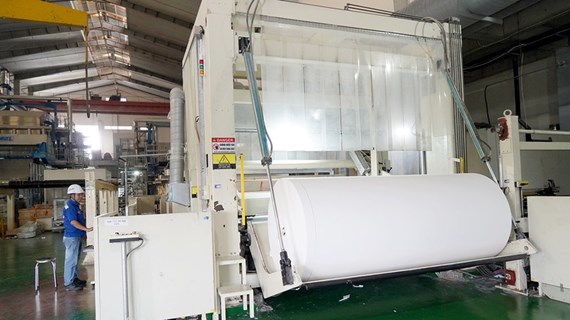Optimism over Vietnam property: investors
A number of real estate companies and experts were quoted by New York
Times as saying that Vietnam’s beleaguered property market is bottoming
out just as macroeconomic indicators stabilise and the Party makes new
pledges to reform a struggling and corruption-riddled banking sector.
A number of real estate companies and experts were quoted by New York
Times as saying that Vietnam’s beleaguered property market is bottoming
out just as macroeconomic indicators stabilise and the Party makes new
pledges to reform a struggling and corruption-riddled banking sector.
Dinh Thien Thien’s barbecue business bloomed just as Vietnam’s property market wilted. It was not a coincidence, according to New York Times.
In 2010, Thien said he rented an empty lot downtown here, where construction had largely stopped, and installed a grill. He added some homemade wooden furniture intended to conjure the image of a saloon - a motif inspired by his love of American westerns. Word of his movable feasts began to spread on Facebook, and within months he was renting 15 lots for the equivalent of 1,000-5,000 USD a month.
But as construction picks up again,Thien, 32, is down to five locations. Some of his former grill sites are dotted with cranes or cement mixers, and he predicts that in three years he will be forced to pursue an entirely new line of work.
Vietnam’s beleaguered property market is bottoming out just as macroeconomic indicators stabilise and the ruling Party makes new pledges to reform a struggling and corruption-riddled banking sector, say developers and businessmen here, the country’s commercial capital. And if Vietnam signs onto the Trans-Pacific Partnership, a proposed trade agreement that involves a dozen countries, including the United States, it may bolster the Vietnamese economy and speed a real estate recovery.
Yet although lending rates have fallen to 12.8 percent, from 20.3 percent in 2011, no one in Vietnam knows whether the market can rebound to the peaks it hit before 2008, much less whether the government’s statistics or commitments to banking reform are reliable. For the moment, the mid- to high-end apartment markets remain oversupplied in this city and in the capital, Hanoi.
“It’s going to be another year before things get more clear - it’s rather opaque at this point,” said Trinh Bao Quoc, chief executive at Son Kim Land Corporation, a local developer. “But if you talk to foreign investors, a lot of them who are here in Vietnam know that this is a good time to buy.”
In this city, asking rates for office rentals, now at about 20-30 USD per square meter, or about 10 square feet, began to rise in late 2012 for the first time since 2007, according to the Los Angeles-based real estate company CBRE. And in recent months, average selling prices for low-end residential properties in Hanoi have held steady around 800 USD per square meter after falling precipitously for two years.
Some foreign investors have bought real estate here this year, in what brokers suggest is a sign of rising liquidity and investor confidence. And a few major construction projects are in the pipeline, including a tower that will include Vietnam’s first Ritz-Carlton.
And in July, Vingroup, a real estate developer in Vietnam, opened the country’s largest shopping mall, which has a gross floor area of more than 200,000 square meters, or 2.1 million square feet. A company spokesman said 53 percent of the 4,518 units at a new apartment complex nearby had already been sold, and 29 percent of them were leased for 50 years.
“We believe the real estate market is recovering well now and is expecting a positive turnaround by the end of this year or early next year,” said Le Thi Thu Thuy, chief executive of Vingroup.
But Viet Nam’s economy has underperformed relative to predictions that accompanied its 2007 entry to the World Trade Organisation, and its current annual growth rate of about 5.3 percent is the slowest in more than a decade. A central obstacle to economic recovery is that local banks are saddled with bad debts linked to speculative property investments.
Credit has tightened in the years since the market began to sour in 2008, and in July the government created an asset management firm tasked with buying bad debts in the banking sector. In September, PM Nguyen Tan Dung also pledged to raise the cap on foreign ownership in local banks to 49 percent from 30 percent.
But analysts say many of the bad debts are still linked to real estate.-VNA
Dinh Thien Thien’s barbecue business bloomed just as Vietnam’s property market wilted. It was not a coincidence, according to New York Times.
In 2010, Thien said he rented an empty lot downtown here, where construction had largely stopped, and installed a grill. He added some homemade wooden furniture intended to conjure the image of a saloon - a motif inspired by his love of American westerns. Word of his movable feasts began to spread on Facebook, and within months he was renting 15 lots for the equivalent of 1,000-5,000 USD a month.
But as construction picks up again,Thien, 32, is down to five locations. Some of his former grill sites are dotted with cranes or cement mixers, and he predicts that in three years he will be forced to pursue an entirely new line of work.
Vietnam’s beleaguered property market is bottoming out just as macroeconomic indicators stabilise and the ruling Party makes new pledges to reform a struggling and corruption-riddled banking sector, say developers and businessmen here, the country’s commercial capital. And if Vietnam signs onto the Trans-Pacific Partnership, a proposed trade agreement that involves a dozen countries, including the United States, it may bolster the Vietnamese economy and speed a real estate recovery.
Yet although lending rates have fallen to 12.8 percent, from 20.3 percent in 2011, no one in Vietnam knows whether the market can rebound to the peaks it hit before 2008, much less whether the government’s statistics or commitments to banking reform are reliable. For the moment, the mid- to high-end apartment markets remain oversupplied in this city and in the capital, Hanoi.
“It’s going to be another year before things get more clear - it’s rather opaque at this point,” said Trinh Bao Quoc, chief executive at Son Kim Land Corporation, a local developer. “But if you talk to foreign investors, a lot of them who are here in Vietnam know that this is a good time to buy.”
In this city, asking rates for office rentals, now at about 20-30 USD per square meter, or about 10 square feet, began to rise in late 2012 for the first time since 2007, according to the Los Angeles-based real estate company CBRE. And in recent months, average selling prices for low-end residential properties in Hanoi have held steady around 800 USD per square meter after falling precipitously for two years.
Some foreign investors have bought real estate here this year, in what brokers suggest is a sign of rising liquidity and investor confidence. And a few major construction projects are in the pipeline, including a tower that will include Vietnam’s first Ritz-Carlton.
And in July, Vingroup, a real estate developer in Vietnam, opened the country’s largest shopping mall, which has a gross floor area of more than 200,000 square meters, or 2.1 million square feet. A company spokesman said 53 percent of the 4,518 units at a new apartment complex nearby had already been sold, and 29 percent of them were leased for 50 years.
“We believe the real estate market is recovering well now and is expecting a positive turnaround by the end of this year or early next year,” said Le Thi Thu Thuy, chief executive of Vingroup.
But Viet Nam’s economy has underperformed relative to predictions that accompanied its 2007 entry to the World Trade Organisation, and its current annual growth rate of about 5.3 percent is the slowest in more than a decade. A central obstacle to economic recovery is that local banks are saddled with bad debts linked to speculative property investments.
Credit has tightened in the years since the market began to sour in 2008, and in July the government created an asset management firm tasked with buying bad debts in the banking sector. In September, PM Nguyen Tan Dung also pledged to raise the cap on foreign ownership in local banks to 49 percent from 30 percent.
But analysts say many of the bad debts are still linked to real estate.-VNA













